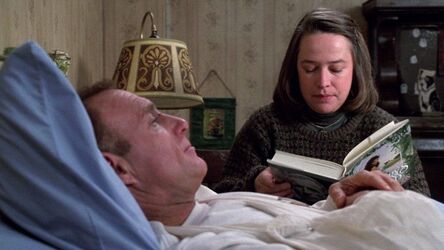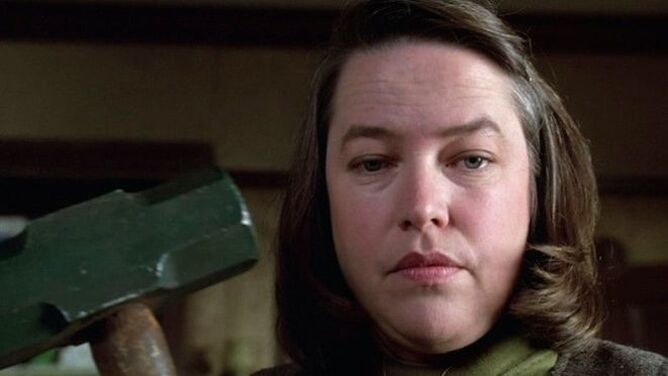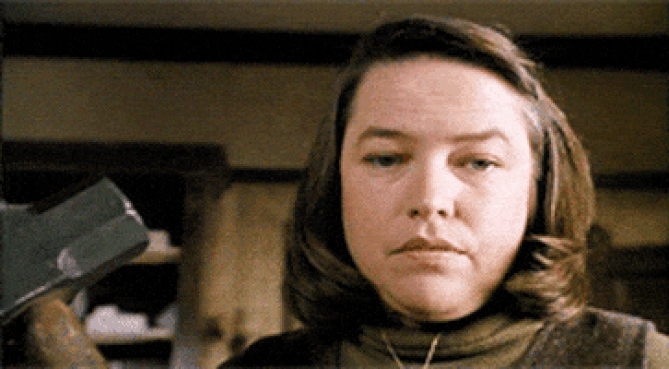 Often a child’s first exposure to horror stories does not come from a sleepaway camp campfire or the late-night monster movie, but instead from classic fairy tales... ...On the surface these tales appear fanciful and full of princesses and happily ever afters. But below their magical exterior, fairy tales expose young readers to evil curses, betrayal, dismemberment, and even death. These stories introduce future horror fans to their first monsters and show them the world, no matter how quaint, holds some darkness. Horror movies and literature, either intentionally or not, pull heavily from the fairy tales of our youth. Even the work of a big name in the genre like Stephen King is no exception. Thirty years ago, Misery trapped viewers in an upstairs bedroom and demonstrated how terrifying an unhindered obsession could become. The protagonist Paul Sheldon (James Caan) finds himself locked away in a proverbial tower and at the mercy of his captress, the all-controlling Annie Wilkes (Kathy Bates). Director Rob Reiner uses feelings of extreme helplessness, toxic fandom, and untreated psychosis to bring a modern spin to an old fairy tale. “Rapunzel” and Misery explore the uncomfortable and claustrophobic fears of unfair imprisonment, the dangers of fanatical control, and even the lessons of learning to rely on yourself to conquer these fears. “Rapunzel” is the story of a witch who locks away a young girl (a baby in some versions) who grows up in a tall tower, never knowing any part of the world outside of her confines and the witch who visits from time to time. The characteristic which sets Rapunzel apart from other fairy tale protagonists is her incredibly long hair, which serves as a means of entrance and exit from the high tower. Rapunzel longs to escape the tower and the witch, and eventually meets a handsome Prince who comes to visit the hapless girl. That is until the witch learns of Rapunzel’s secret rendezvous and puts a stop to the prince by allowing him to fall from the tower into a massive pricker bush. The story ends with Rapunzel birthing twins and then wandering the world forever. Sometimes she finds the prince, sometimes she does not. With this brief refresher of the non-Disnified version of “Rapunzel” in mind, we can now talk about the King/Reiner retelling of this classic tale. Like the witch, Annie Wilkes longs for a companion and sets her sights on her favorite writer, Paul Sheldon. During a horrific road accident, Annie rescues the badly mangled Paul and whisks him away to the safety of her secluded and hard to reach second floor bedroom. Not quite the tower of fairy tale fame, perhaps, but mostly impenetrable because of the weather and Paul’s injuries from the accident. Needless to say, Paul has few options for escape. The characters in Misery play a role reversal; the trapped figure is older, but Paul’s injuries place him in an undeniably vulnerable position, as evident from his physical wincing and writhing in pain. Beyond physical discomfort, his necessity for a wheelchair creates a significant height difference, which allows for the 5’3” frame of Kathy Bates to take on a looming and intimidating presence over James Caan. In “Rapunzel”, the sorceress serves as a substitute mother for the title character, but in Misery, Annie serves as the matriarchal character in Paul’s life. Not only does she claim to look out for his physical well-being, but also his literary accomplishments. She nourishes his body, but also his mind as her unrealistic version of Paul turns her violent when the author strays from her expectations. Where the witch of the original tale fears losing Rapunzel, Annie fears the loss of both the fictional character of Misery and her fictional version of Paul. She forces Paul to write another book to fix the “mistakes” of his previous novel. The character Misery brought comfort to Annie during long nights and if Paul leaves the tower, then she loses Misery as well. Therefore, Paul becomes a personified version of Misery—someone Annie can idolize, dote on, and above all, love. Misery is Annie’s obsession and, if she cannot have her, no one will. In the fairy tale, Rapunzel eventually learns about the outside world because a prince hears her singing, and they begin a relationship. The couple plans to leave the tower, but when the witch discovers their affair she seriously injures (or kills) the man in an attempt to keep Rapunzel for her own. In Misery, Paul’s Prince Charming comes in the unlikely package of the elderly sheriff Buster (Richard Farnsworth) a greying, yet dedicated law enforcer who treks through the wilderness and faces evil all in attempts to bring Paul home. And, just as the prince from the Grimms’ version, the sheriff learns about Paul’s whereabouts because he hears Paul’s voice—or at least the lost writer’s words. In the most common version of “Rapunzel”, the witch tricks the prince into climbing the hair, only to let him tumble into the briar patch causing, at the very least, his blindness. Since Misery is a Stephen King fairy tale, the prince does not get off as easily. Instead, Buster tumbles down the stairs after a shotgun blast through the back. He expected to save Paul, only to be tricked by Misery’s version of the witch. As Paul’s book nears completion, the writer gains more strength, much like Rapunzel’s coming of age. Annie’s fear of losing Paul grows more and more and, as the fantasy blinders inspired by the Misery series begin to slip, Annie knows physical measures must be taken. In a speech about slaves working in a diamond mine—and one of the film’s most memorable sequences—Annie explains the meaning of “hobbling”. Hobbling, she says, is a method of preventing escape in which the captor breaks the ankles of the captee. Annie hobbles both Paul’s legs, but claims she does so for love. Similarly, the witch performs a form of hobbling when she cuts off Rapunzel’s hair. Her lengthy locks served as Rapunzel’s only means of escape and now, like Paul, she will need a significant amount of time to “heal” from her attack. In the end of the Grimm tale, the witch casts out Rapunzel to fend for her herself in the wilderness. Only once she’s on her own does Rapunzel learn any independence. So, the now abandoned girl takes her twin babies and explores the world outside the tower. In Misery, Paul finally earns solitude when he kills Annie. Despite the experience that earns the label of the worst horror of his life, he still thanks Annie for helping him. He learned how to find independence from his publishers, the critics, and his fan favorite character who brought him fame. Paul even “births” his own twins, as his time in captivity helps him create both a new Misery novel and a non-fiction book about his horrific ordeal. Using “Rapunzel” as a key to unlock some of the horrors we experience when watching Misery allows for a better understanding of the root of the horrors. Annie might not be a recognizable character from our real lives, but the fantasy world from our childhoods first exposed us to controlling and unpredictable witches. King and Reiner took a villain right out of Grimms’ and placed her in a modern setting. The story and characters heavily reflect the fears from “Rapunzel”, but with a more grown-up premise so that, even as adults, we can still feel the terror first introduced to us in our youth. By Amylou Ahava
0 Comments
Leave a Reply. |
Archives
March 2023
|


 RSS Feed
RSS Feed